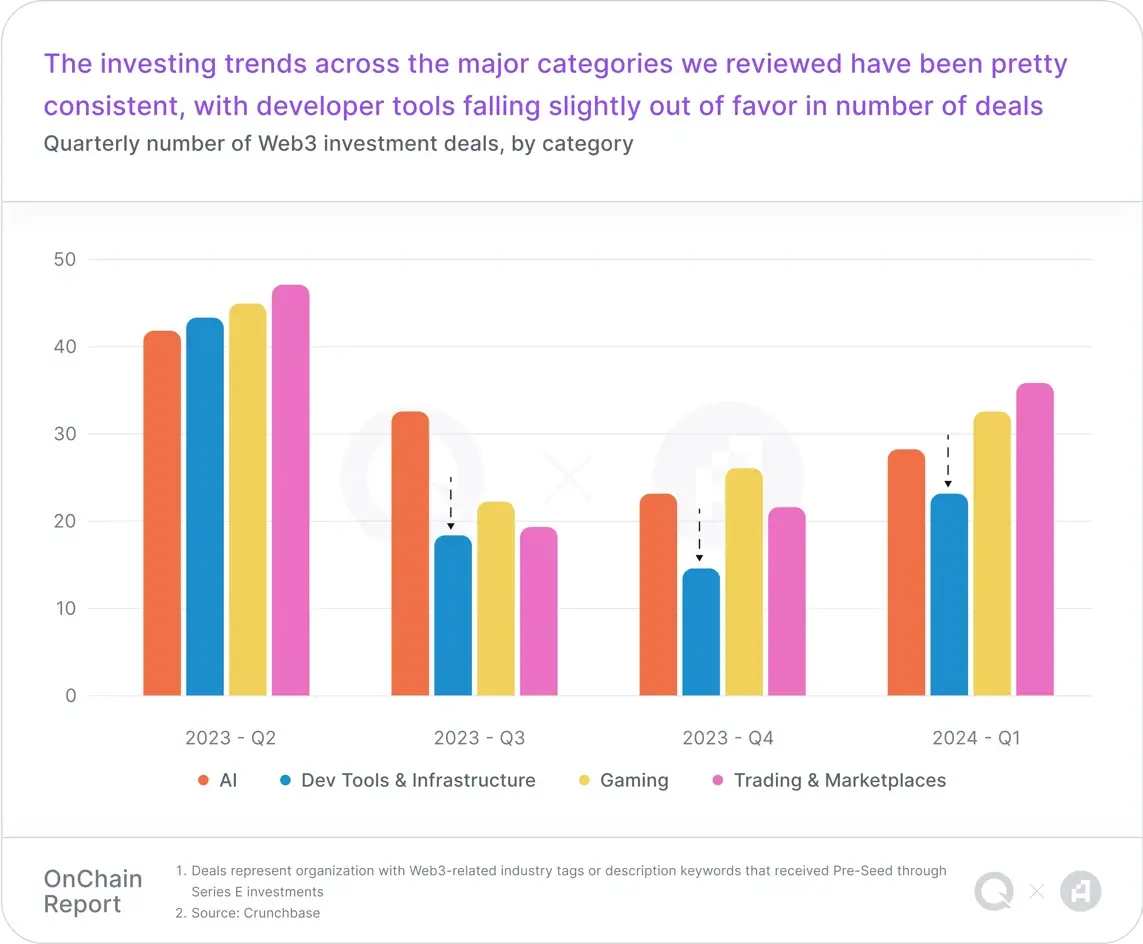Summary
- Stablecoin activity surges : Stablecoin user activity surged 42% month-on-month due to a combination of factors including the approval and listing of spot Bitcoin ETFs, April’s Bitcoin halving, exodus from hyperinflationary fiat currencies, and the resurgence of DeFi.
- Reigniting the “DeFi Summer” : In the first quarter of 2024, DeFi entered a new era characterized by optimism, risk awareness, and sophisticated innovation. DeFi user activity increased by 291% month-on-month, and the market has rekindled hopes for a "DeFi Summer".
- The Web3 game is heating up : the number of active addresses increased by 155% month-on-month, and the significant increase in player participation demonstrates Web3's ability to attract and retain a growing number of players.
- Layer 2 Rapid Extension Kit : The Layer 2 Rapid Extension Kit marks a critical step forward in Web3 extension kits over the past six months. In particular, the significant growth in TVL on platforms such as Base shows that the market still has interest in expanding on-chain liquidity.
user activity
Stablecoin
It has the most active addresses for five consecutive quarters, accounting for more than 41% of all daily active addresses (DAA). USDT continues to dominate stablecoins, accounting for around 75% of the total stablecoin market capitalization. In the first quarter of 2024, USDT’s market capitalization exceeded $100 billion for the first time.
Although USDT processed more than 10 times the number of transactions than USDC in Q1’24, USDC leads the way in terms of transaction volume and average transaction size.

DeFi
The number of daily active addresses in DeFi increased by 291% quarter-on-quarter in the first quarter. This growth represents a resurgence in capital inflows and the emergence of new revenue-generating protocols that fuel increased user activity.
DeFi truly entered a new era in the first quarter of 2024, with a huge increase in developer and user activity, especially Solana and the Base network. Staking, liquidity staking, re-staking, and liquidity re-staking have all been catalysts for DeFi’s recent explosive growth, which explains why staking now accounts for a large portion of DeFi TVL.
While stablecoins still top the list of address activity, DeFi surpassed stablecoins in terms of transaction volume, with an average daily transaction volume of nearly 7 million at the end of the quarter. TVL for revenue-generating protocols has steadily climbed from $26.5 billion in Q3'23 to $59.7 billion in Q1'24. This rally signals a return of confidence and liquidity in the DeFi market.
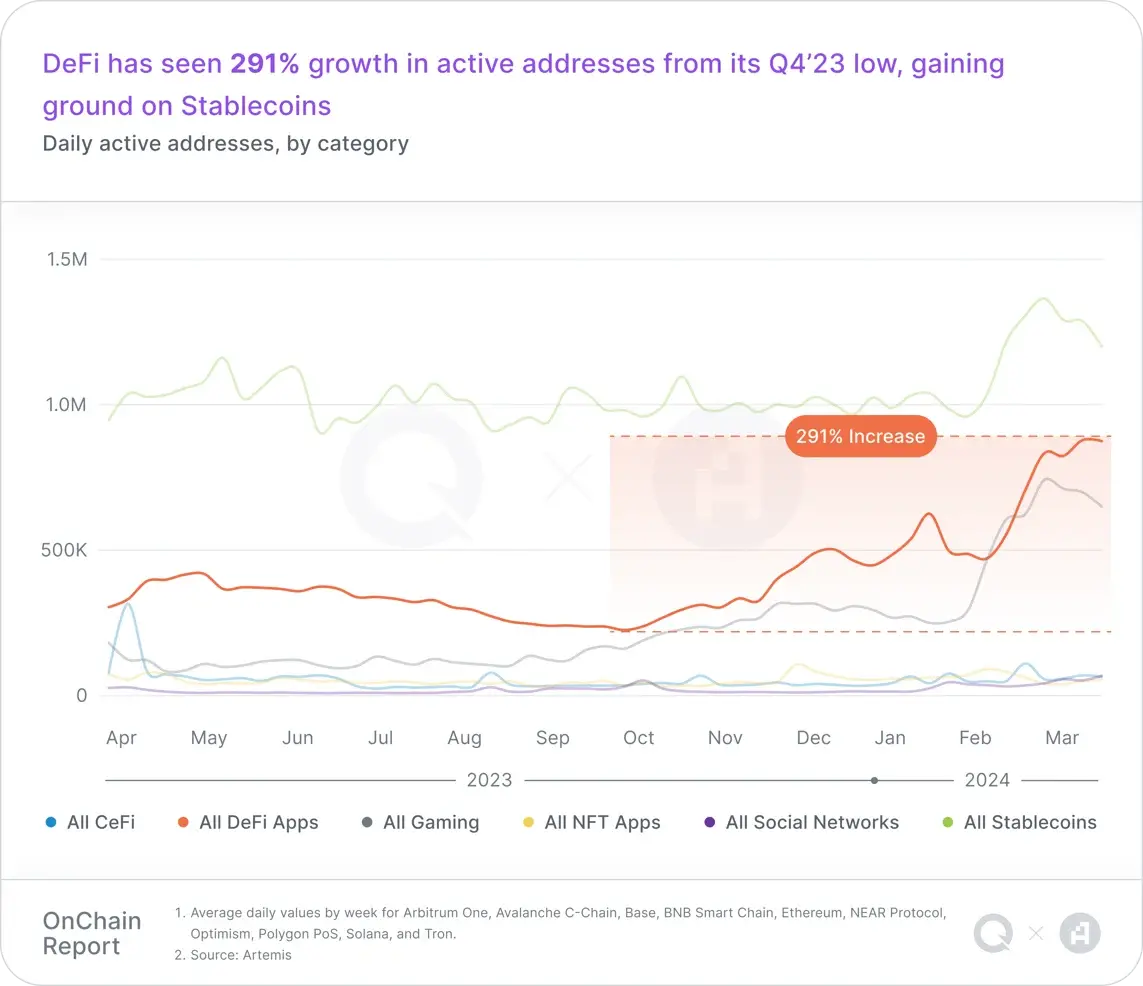
Web3 games
The Web3 gaming track has experienced significant growth, surpassing stablecoins in transaction volume and becoming the fastest growing Web3 category year-on-year. Compared to Q4 23, Web3 Games’ daily active addresses increased by 155% in Q1 24, reaching a peak of 747,000. The number of transactions on the Web3 game track increased by 370% year-on-year.

Decentralized social platform
Decentralized social networks experienced rapid growth in the first quarter of 2024, with user activity increasing by 425%, indicating the market’s growing interest in blockchain-based social platforms. Mainstream platforms include Farcaster, Lens, and friend.tech and Tomo.
Extended reading: Comment》Farcaster’s encrypted social networking success makes Lens very anxious
Historically, initial user engagement in decentralized social networks has declined as the novelty of “uniqueness and novelty” gradually wears off. However, the gradual increase in the number of active users after the first quarter peak suggests that user engagement will become more stable over time, which may be a potential signal of increasing user acceptance.

NFT market
In 2023, Ethereum far outpaced other chains in terms of NFT market transaction volume, but in Q1’24, the Solana NFT market saw a surge in transaction volume and activity.
While OpenSea and Magic Eden have historically dominated the daily NFT active addresses and NFT transaction count respectively, this trend was overtaken by Tensor in Q1’24, indicating changes in user preferences and platform performance.
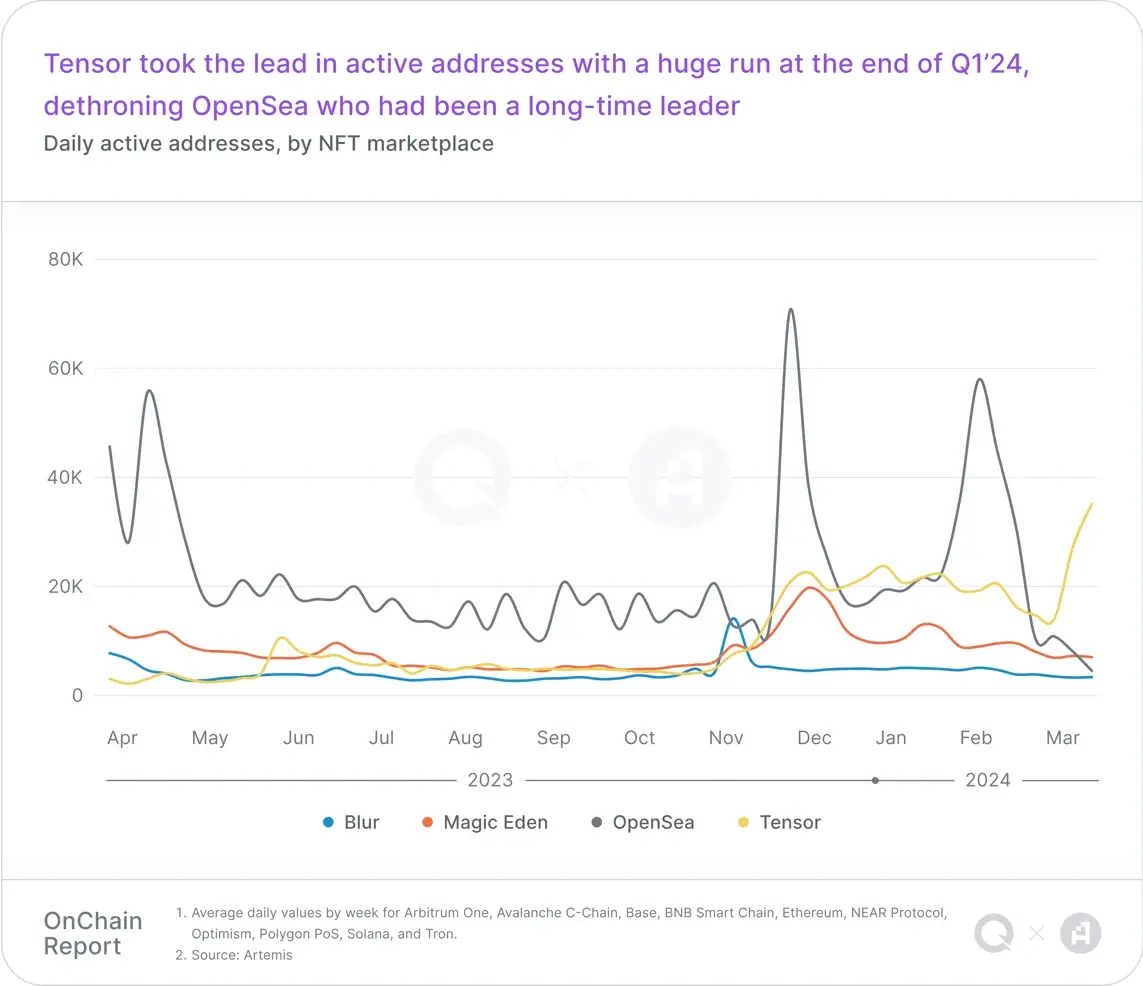
Public chain
Layer 2 and sidechains
Layer 2 solutions significantly improve blockchain's scalability in Q1'24, with faster transaction speeds and lower costs, helping to solve key challenges such as congestion and high transaction fees on major networks . The Layer 2 market is constantly expanding, with new chains being launched every quarter.

Arbitrum
Despite fierce competition, Arbitrum has long been the L2 leader with 44% of TVL across all Ethereum Layer 2 s.
In Q1'24, Arbitrum experienced two significant events within a few days. The first event was the Dencun upgrade of the Ethereum network on March 13, which reduced L2 transaction fees by 98%. Artemis data shows that average daily transaction volume has almost doubled, growing by 96.2%, and average transaction fees have dropped by 93.5% (i.e., average Arbitrum transaction fees have dropped from $0.3 to $0.01 almost overnight), but revenue has only dropped by 62.6%. In short, the Ethereum upgrade makes Arbitrum more suitable for mass-market applications.
The second event was the massive Arbitrum token unlock on March 16th. With 1.1 billion ARB tokens worth $2.32 billion unlocked, the circulating supply of ARB tokens has nearly doubled.
The unlocked ARB was sold by some whales (Note: According to Lookonchain monitoring, after the large-scale unlocking, 11 whales deposited a total of 34 million ARB to the exchange, about 58 million US dollars), and then there were large investors selling, although Arbitrum The TVL has remained essentially unchanged, while daily active addresses and transaction volume have surged.
Further reading: Arbitrum’s new proposal: Expand the deployment of Orbit chain on any blockchain other than Ethereum
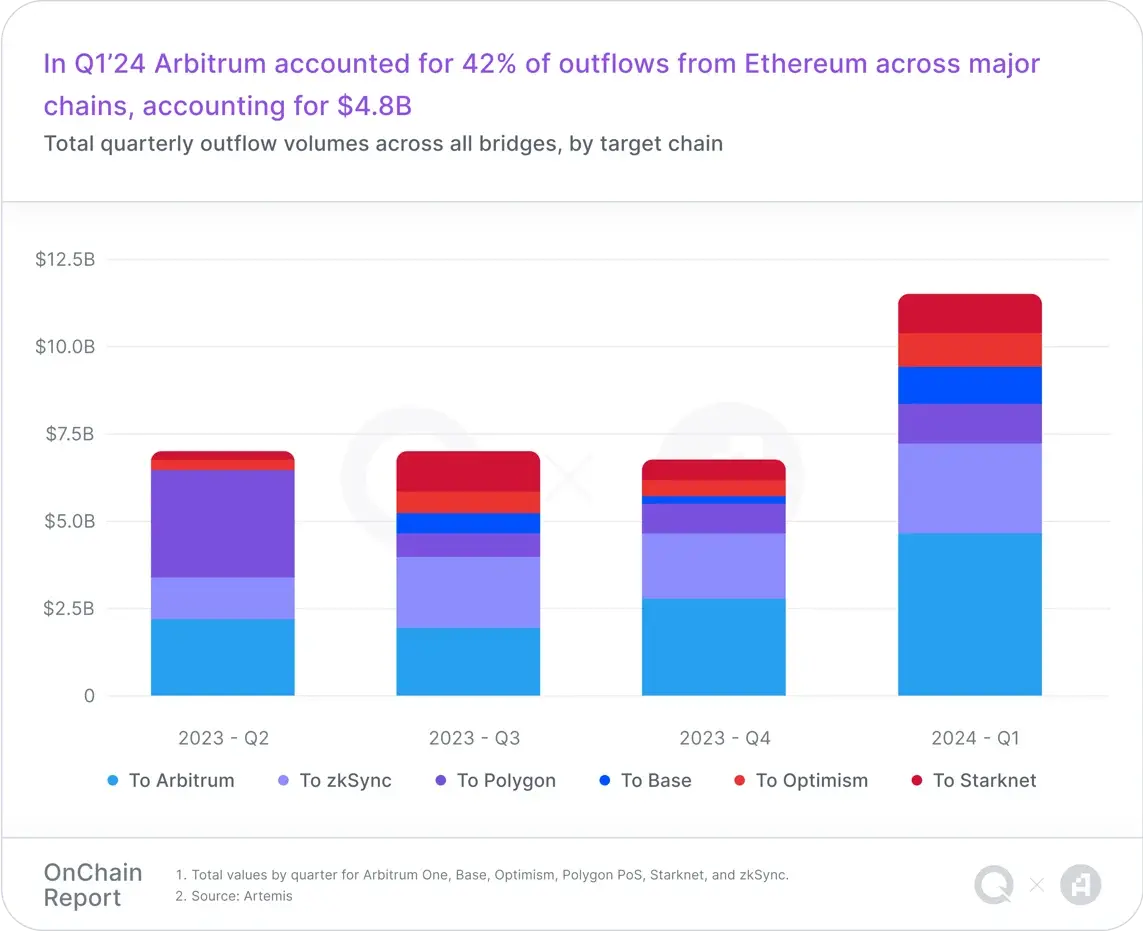
Base
Coinbase’s new L2 network Base reached a major milestone in Q1’24, with TVL exceeding $1 billion. After the upgrade of Ethereum, the daily trading volume of DEX in the Base ecosystem reached its highest level ever in March, soaring 487%, and the daily trading volume exceeded US$1 billion for the first time.
While Uniswap is Base’s largest DEX trading platform to date, Base has become fertile ground for emerging DEXs. Aerodrome, in particular, has become the second-ranked DEX in terms of trading volume and TVL on the Base network. Base has also achieved tremendous growth in areas such as decentralized social applications. For example, Farcaster achieved great success in the first quarter. In addition, Memecoin is gradually being regarded by large ecosystems as a way to attract new users and gain community attention. one.
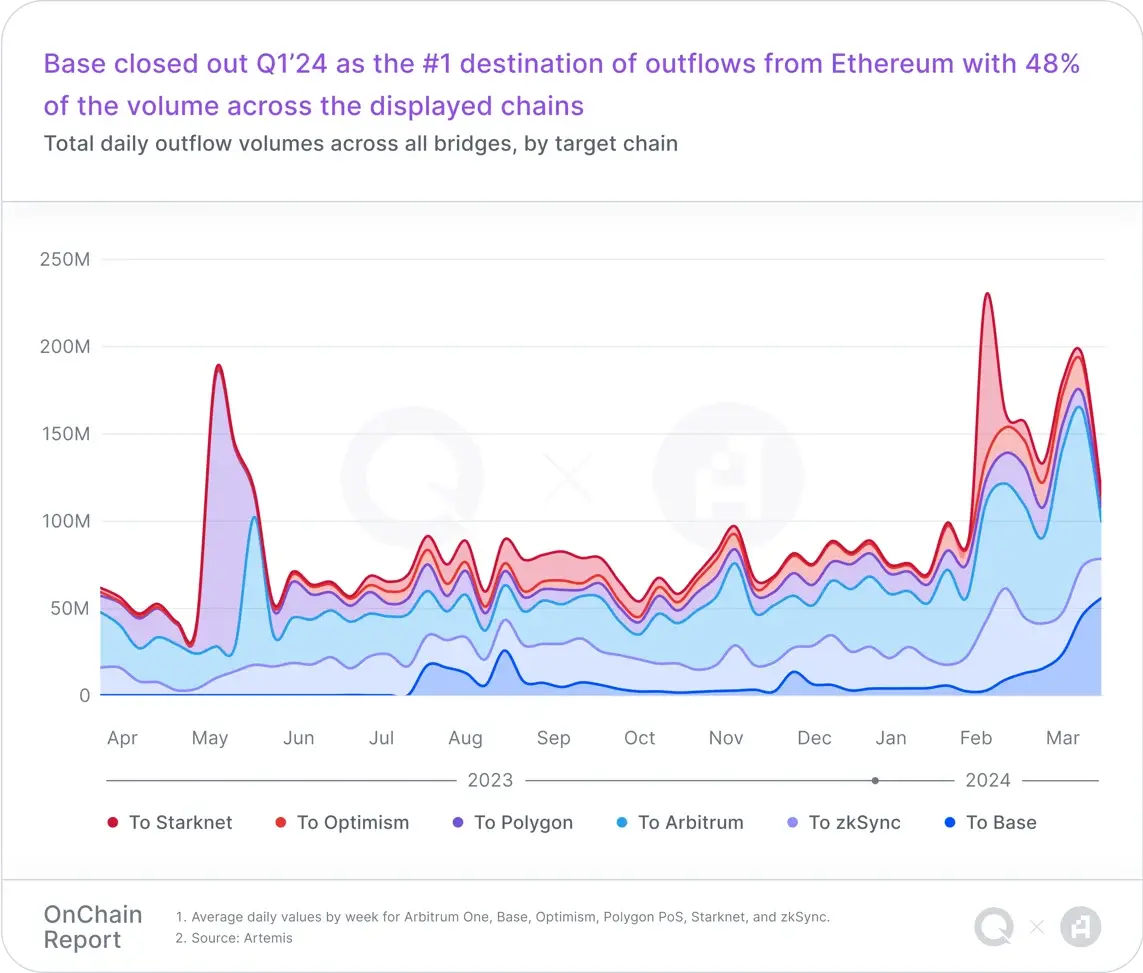
Polygon
Polygon released AggLayer v1 Mainnet on February 23, which introduced the aggregation layer (AggLayer). This cross-stack communication tool aims to unify fragmented blockchains into a network of zk-protected L1 and L2 chains that feel like a single chain.
Additionally, Polygon is using its Chain Development Kit (CDK) to verify configurations transitioning from sidechains to L2 networks. Although Polygon's number of active developers continues to decline, it still maintains its second position.
Extended reading: OKX cooperates with Polygon to release zkEVM L2 network "X1", OKB rises by more than 35% in a single month and hits a new record high
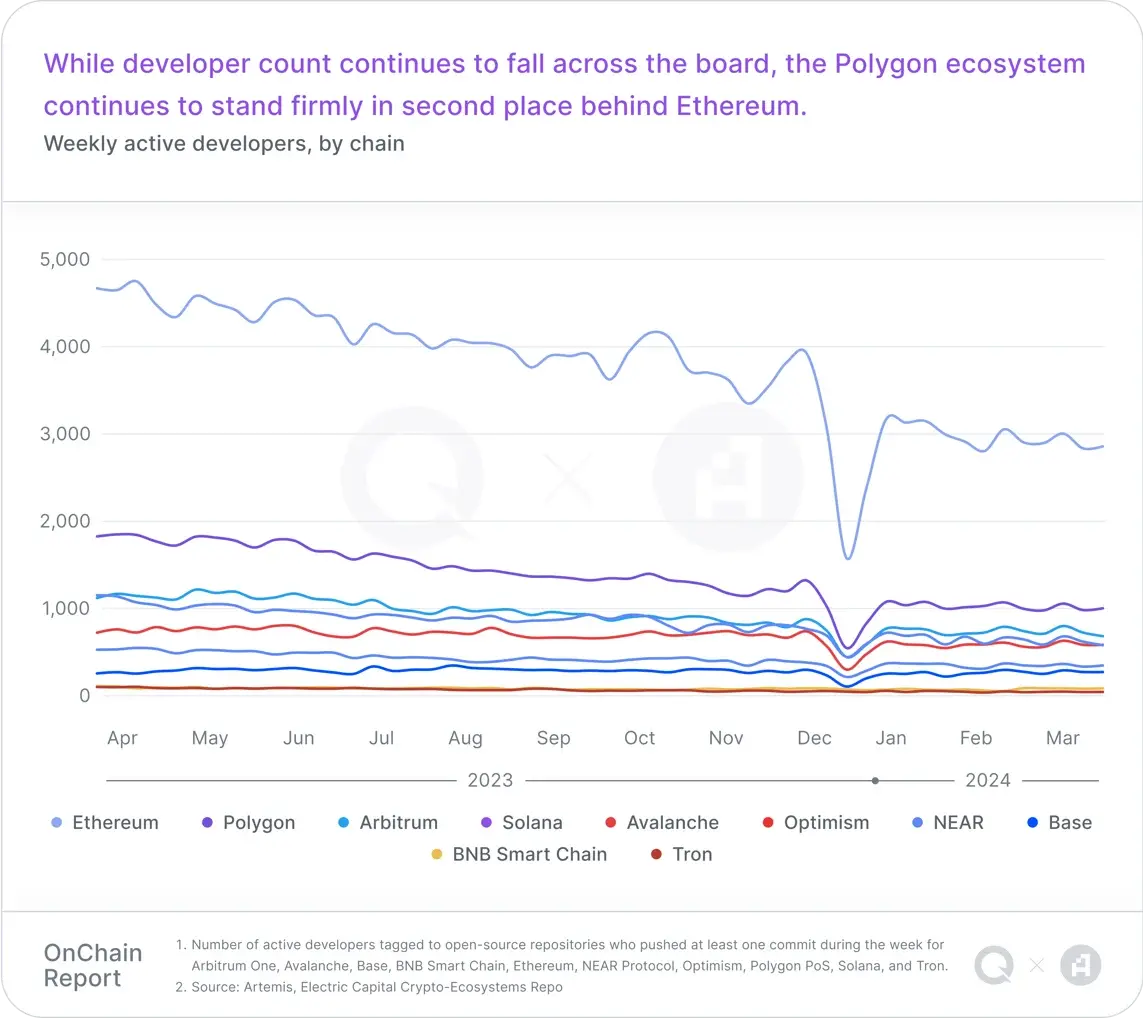
Solana
In Q1’24, the Solana Foundation launched a token extension suite that provides a range of configurable features for stablecoin issuers such as GMO Trust and Paxos. Solana gradually became a paradise for retail investors, DeFi innovators, NFT minters, airdrop opportunists, and Memecoin traders in Q1’24. The influx of new address activity helped Solana’s average daily DEX trading volume increase by 180% month-on-month to $1.2 billion.
Solana revenue (in U.S. dollars) surged 597% sequentially, from $7.1 million in Q4 '23 to $49.5 million in Q1 '24. The market value of the Solana ecosystem's stablecoins also increased by 49.4% month-on-month, from US$1.9 billion to US$2.9 billion.
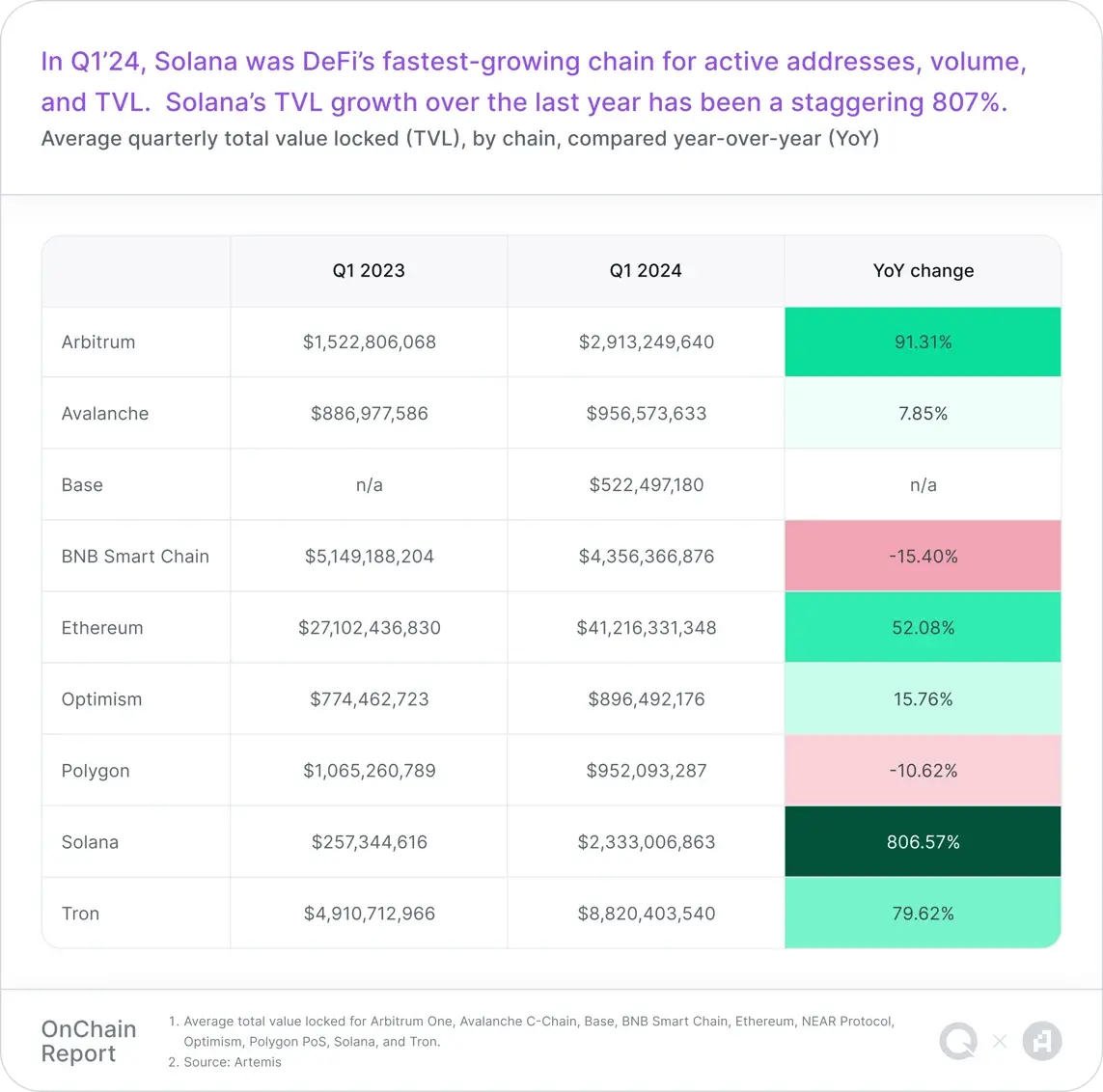
Financing review
In addition to a 36% quarter-on-quarter increase in funding volume, Web3's total funding increased by 55% compared to Q4 23. The number of seed round financings increased the most significantly, with a month-on-month increase of 53%. Series A and seed funding increased significantly, almost doubling the previous quarter. Among funding categories, AI was the most popular, demonstrating strong interest in exploring how AI can become a key value driver for Web3.
In contrast, areas such as developer tools and transactions saw only modest increases in funding and volume, suggesting a more cautious investor attitude, possibly due to uncertainty or lower short-term returns in these areas.
Overall, growth in the Web3 venture market has resumed and highlights strategic shifts in industries that VCs believe will have a significant impact and drive the evolution of the blockchain landscape.

